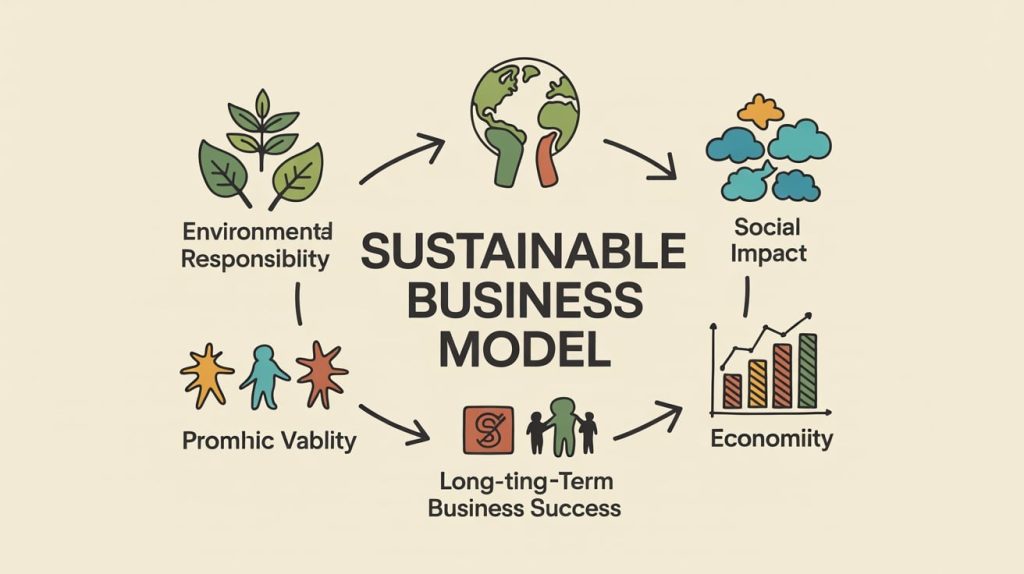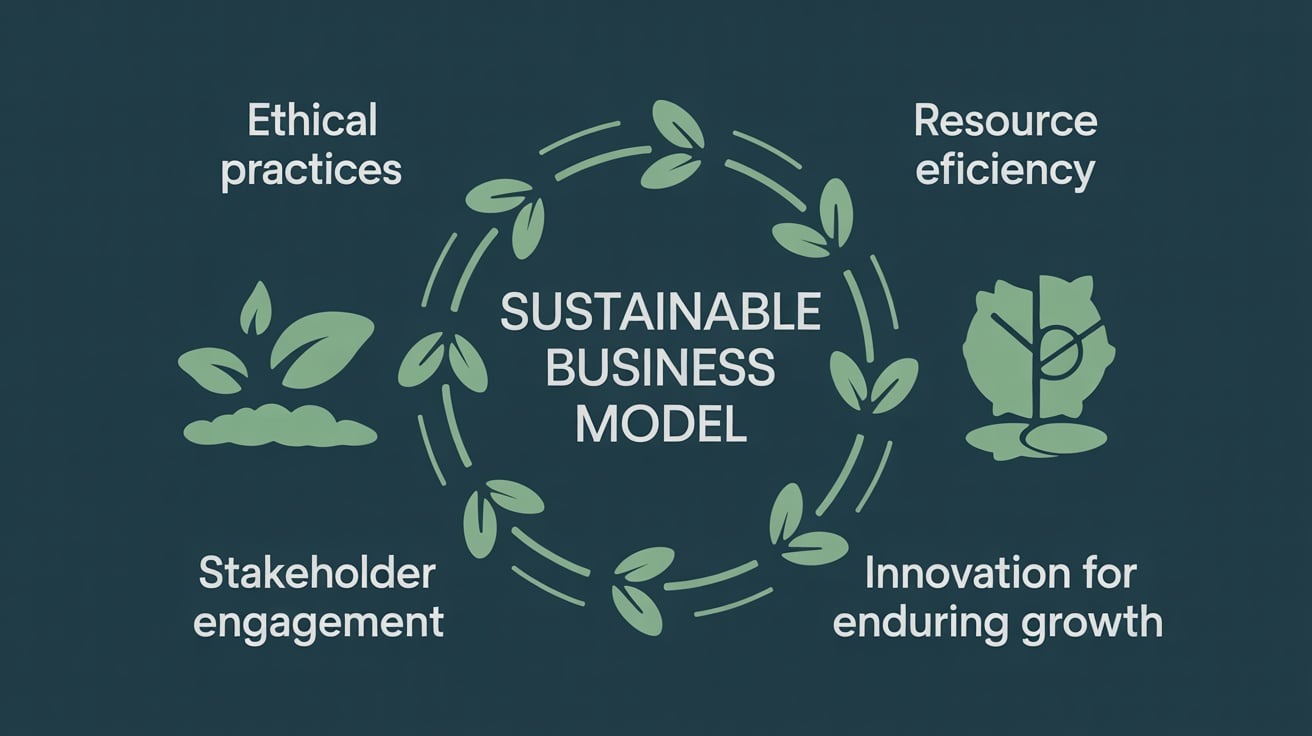
In today’s rapidly evolving business landscape, companies face unprecedented challenges that demand innovative approaches to long-term viability. Traditional profit-maximizing strategies are no longer sufficient to ensure sustained success. Modern businesses must embrace sustainable practices that balance economic prosperity with environmental stewardship and social responsibility.
Thank you for reading this post, don't forget to subscribe!The concept of sustainable business models has evolved from a niche consideration to a fundamental requirement for competitive advantage. Organizations that integrate sustainability into their core operations demonstrate remarkable resilience during economic uncertainties. Additionally, these businesses attract conscious consumers, talented employees, and forward-thinking investors who prioritize long-term value creation over short-term gains.
Understanding the principles of sustainable business models becomes crucial for entrepreneurs and established companies alike. These principles provide a framework for building enterprises that generate lasting value while contributing positively to society and the environment. Therefore, implementing these guidelines can transform traditional business approaches into powerful engines of sustainable growth.
The Foundation of Sustainable Business Thinking
Sustainable business models fundamentally shift the traditional paradigm from purely profit-driven objectives to a more holistic approach. This transformation requires businesses to consider their impact on multiple stakeholders, including customers, employees, communities, and the environment. However, this shift doesn’t mean sacrificing profitability; instead, it creates new opportunities for value creation and competitive differentiation.
The foundation rests on the understanding that businesses operate within interconnected systems. Environmental degradation, social inequality, and economic instability ultimately affect business performance. Consequently, companies that proactively address these challenges position themselves for long-term success while those that ignore them face increasing risks and limitations.
Moreover, sustainable thinking encourages innovation and creativity. When businesses consider environmental and social constraints as design parameters rather than obstacles, they often discover breakthrough solutions that create both competitive advantages and positive impact. This approach has led to numerous success stories across various industries.
Core Principle 1: Environmental Stewardship and Resource Efficiency
Environmental stewardship represents the cornerstone of sustainable business models. Companies must minimize their ecological footprint through resource efficiency, waste reduction, and clean energy adoption. This principle extends beyond compliance with environmental regulations to proactive leadership in environmental protection.
Resource efficiency initiatives often generate significant cost savings while reducing environmental impact. Businesses can implement circular economy principles, where waste from one process becomes input for another. Additionally, investing in renewable energy sources and sustainable materials creates long-term operational advantages and brand differentiation.
Water conservation, carbon footprint reduction, and biodiversity protection are essential components of environmental stewardship. Companies that excel in these areas often discover unexpected benefits, including improved operational efficiency, enhanced brand reputation, and access to new markets that prioritize environmental responsibility.
Core Principle 2: Social Responsibility and Stakeholder Engagement
Social responsibility encompasses fair labor practices, community engagement, and ethical business conduct. Sustainable businesses recognize that their success depends on the well-being of all stakeholders, not just shareholders. This principle involves creating positive social impact while maintaining profitable operations.
Employee welfare and development form critical aspects of social responsibility. Companies that invest in their workforce through fair wages, professional development, and inclusive cultures experience higher productivity, lower turnover, and stronger innovation capabilities. Furthermore, these practices enhance the company’s ability to attract and retain top talent in competitive markets.
Community engagement involves partnering with local organizations, supporting education initiatives, and contributing to regional economic development. Businesses that actively participate in community building create strong local support networks and enhance their social license to operate. Therefore, social responsibility becomes a strategic investment in long-term business viability.
Core Principle 3: Economic Viability and Long-term Value Creation
Economic viability ensures that sustainable practices contribute to long-term financial health rather than compromising profitability. This principle requires careful balance between sustainability investments and financial returns. However, research consistently shows that sustainable businesses often outperform their traditional counterparts over extended periods.
Long-term value creation involves building business models that generate sustained returns while adapting to changing market conditions. Sustainable businesses typically demonstrate greater resilience during economic downturns and crises. Additionally, they attract patient capital from investors who prioritize long-term growth over short-term profits.
Innovation in sustainable products and services often opens new revenue streams and market opportunities. Companies that pioneer sustainable solutions frequently become market leaders and enjoy competitive advantages that traditional approaches cannot replicate. Therefore, economic viability and sustainability reinforce each other rather than competing for resources.
Core Principle 4: Innovation and Continuous Improvement
Innovation drives sustainable business models by creating solutions that address environmental and social challenges while generating economic value. This principle requires companies to foster cultures of creativity, experimentation, and continuous learning. Sustainable innovation often leads to breakthrough technologies and business models that transform entire industries.
Continuous improvement involves regularly evaluating and enhancing sustainability practices. Businesses must establish metrics, monitor progress, and adjust strategies based on performance data and changing circumstances. Additionally, staying informed about emerging sustainability trends and technologies enables companies to maintain competitive advantages.
Collaboration with external partners, including suppliers, customers, research institutions, and NGOs, accelerates innovation in sustainable practices. These partnerships provide access to diverse perspectives, specialized expertise, and shared resources that individual companies cannot achieve alone. Therefore, innovation becomes a collaborative effort that benefits entire ecosystems.
Core Principle 5: Transparency and Accountability
Transparency and accountability build trust with stakeholders and demonstrate genuine commitment to sustainable practices. This principle requires honest communication about both successes and challenges in sustainability efforts. Companies must provide regular reports on their environmental, social, and economic performance using standardized metrics and frameworks.
Accountability involves setting measurable goals, tracking progress, and taking responsibility for outcomes. Sustainable businesses often adopt third-party certifications and audits to verify their claims and ensure continuous improvement. Additionally, they engage stakeholders in meaningful dialogue about their sustainability journey and incorporate feedback into their strategies.
Transparent communication extends to supply chain practices, ensuring that sustainability commitments are maintained throughout the value chain. Companies must work with suppliers and partners to maintain consistent standards and address any issues that arise. Therefore, transparency becomes a foundation for building sustainable business ecosystems.

Implementation Strategies for Sustainable Business Models
Implementing sustainable business models requires systematic approaches that integrate sustainability into core business processes. Organizations should start by conducting comprehensive sustainability assessments to identify opportunities and challenges. This analysis provides the foundation for developing targeted strategies and action plans.
Leadership commitment is essential for successful implementation. CEOs and senior executives must champion sustainability initiatives and allocate necessary resources for their success. Additionally, sustainability should be incorporated into performance metrics and incentive systems to ensure organization-wide alignment and commitment.
Employee engagement and training programs help build internal capacity for sustainability initiatives. Organizations should provide education about sustainability principles, share best practices, and encourage employee participation in sustainability projects. Therefore, successful implementation requires both top-down leadership and bottom-up engagement throughout the organization.
Measuring Success and Impact
Measuring the success of sustainable business models requires comprehensive metrics that capture environmental, social, and economic performance. Companies should adopt established frameworks such as the Global Reporting Initiative (GRI) or the Sustainable Development Goals (SDGs) to ensure consistent and comparable reporting.
Key performance indicators should include both quantitative and qualitative measures. Environmental metrics might include carbon emissions, water usage, and waste reduction. Social indicators could encompass employee satisfaction, community impact, and customer loyalty. Economic measures should evaluate long-term profitability, market share, and stakeholder value creation.
Regular monitoring and reporting enable companies to track progress, identify areas for improvement, and communicate achievements to stakeholders. Additionally, benchmarking against industry peers and best practices helps organizations understand their relative performance and identify opportunities for enhancement.
Challenges and Solutions in Sustainable Business Development
Developing sustainable business models presents various challenges that require creative solutions and persistent effort. Initial investment requirements can be substantial, requiring companies to balance short-term costs with long-term benefits. However, many sustainability initiatives generate positive returns on investment over time.
Market acceptance and customer education represent ongoing challenges for sustainable businesses. Companies must effectively communicate the value propositions of sustainable products and services to overcome consumer hesitation and price sensitivity. Additionally, building market demand often requires collaborative efforts across industries and sectors.
Regulatory complexity and changing requirements create uncertainty for sustainable business planning. Organizations must stay informed about evolving regulations and proactively engage with policymakers to shape favorable regulatory environments. Therefore, successful sustainable businesses maintain flexibility and adaptability in their strategic planning.
The Future of Sustainable Business Models
The future of sustainable business models looks increasingly promising as consumer awareness, investor interest, and regulatory support continue to grow. Technology advances are creating new opportunities for sustainable innovation, while climate change and social challenges are driving demand for sustainable solutions.
Emerging trends include circular economy principles, digital sustainability platforms, and integrated reporting frameworks that capture multiple forms of value creation. Additionally, younger generations of consumers and employees are prioritizing sustainability in their decision-making, creating long-term market shifts that favor sustainable businesses.
Companies that embrace sustainable business models today are positioning themselves for future success in a world where sustainability becomes increasingly important for competitive advantage. Therefore, the transition to sustainable business models represents both an immediate opportunity and a long-term necessity for business success.
Read More Also: What Are the Pros and Cons of UV Air Purifiers
Conclusion
The principles of sustainable business models provide a comprehensive framework for building enterprises that create lasting value for all stakeholders. Environmental stewardship, social responsibility, economic viability, innovation, and transparency form the foundation of sustainable business success. These principles work together to create resilient organizations that thrive in changing market conditions while contributing positively to society and the environment.
Implementing sustainable business models requires commitment, resources, and patience, but the benefits extend far beyond traditional financial metrics. Companies that embrace these principles often discover new opportunities for growth, innovation, and competitive advantage. Additionally, they build stronger relationships with customers, employees, and communities while contributing to a more sustainable future.
The transition to sustainable business models is not just an ethical imperative but a strategic necessity in today’s interconnected world. Organizations that proactively adopt these principles will be better positioned to navigate future challenges and capitalize on emerging opportunities in the sustainable economy.
Read More Also: Binder in Real Estate: Meaning, Purpose
Frequently Asked Questions
Q: How long does it take to implement a sustainable business model?
A: Implementation timelines vary depending on company size and current practices, but most organizations see initial results within 6-12 months. Complete transformation typically takes 2-5 years, with continuous improvement being an ongoing process.
Q: Do sustainable business models cost more to implement than traditional approaches?
A: While initial investments may be higher, sustainable business models often generate cost savings through resource efficiency, waste reduction, and operational improvements. Long-term studies show that sustainable businesses frequently outperform traditional competitors financially.
Q: How can small businesses implement sustainable practices with limited resources?
A: Small businesses can start with low-cost initiatives such as energy efficiency improvements, waste reduction programs, and local sourcing. Many sustainable practices actually reduce costs and can be implemented gradually as resources become available.
Q: What role do customers play in sustainable business success?
A: Customers are crucial stakeholders who drive demand for sustainable products and services. Businesses must educate customers about sustainability benefits and value propositions while incorporating customer feedback into their sustainability strategies.
Q: How do companies measure the success of their sustainable business models?
A: Success measurement requires comprehensive metrics covering environmental impact, social responsibility, and economic performance. Companies typically use established frameworks like GRI or SDGs, combined with industry-specific indicators and stakeholder feedback to evaluate their progress.
